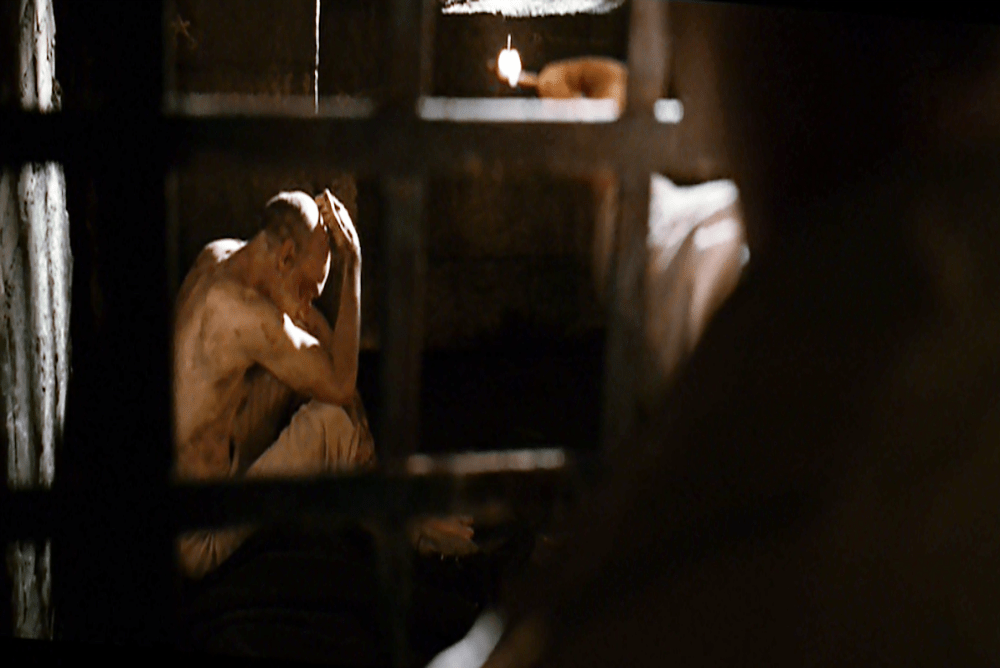The central point of debate about Martin Scorsese’s Shutter Island (2010), as well as the 2003 novel by Dennis Lehane, is whether the main character (played by Leonardo Di Caprio) is insane or not. Is he Teddy Daniels, a US Marshal who has uncovered a terrifying conspiracy involving experiments on patients at Ashecliffe Hospital? Or is he Andrew Laeddis, a man suffering from a profound delusion that he is a US Marshal because he is unable to confront the truth that two years ago he murdered his wife after she drowned their three children?
I think you can make a convincing argument for both interpretations—part of the brilliance of both novel and film. Here, I just want to point out one specific moment in the film, one that resonates with a classic horror film and that may (or may not) help tip the scales.
Two-thirds of the way through Shutter Island, Teddy Daniels/Andrew Laeddis is in Ward C, where the most violent prisoners are kept, and he hears someone call out “Laeddis.” Moving toward the voice, he repeatedly lights matches in the darkness, trying desperately to “see” (in all kinds of ways). In the frame above, he has arrived at the cell of George Noyce (Jackie Earle Haley)—a man at the very heart of either Andrew Laeddis’s delusion or Teddy Daniels’s conspiracy. We have a shot of Teddy/Andrew’s face, match lit, looking, and then we have the shot below of Noyce, curled up, features indistinguishable. As the two men talk, we’re not sure what Teddy/Andrew learns. Does he learn that the conspiracy exists (that Noyce has been drugged and experimented on by the doctors at Shutter Island)? Or does he find evidence that he (Andrew) has brutally beaten Noyce for confronting him with the truth that he murdered his wife? The frail flame of the match, the darkness, Teddy/Andrew’s confused and horrified expression, Noyce’s indistinct features, and the ambiguity of their words all render the scene fundamentally indeterminate.
This moment in Shutter Island evokes, I think, a scene in the 1956 film, Invasion of the Body Snatchers (Don Siegel); in fact, Shutter Island references this film throughout—not least, because Invasion is also about a man, Miles Bennell (Kevin McCarthy), who is convinced there is a vast conspiracy (an alien takeover) but who also may well be insane. The famous scene near the end of the film suggests he’s mad, as he wildly (madly) screams “They’re here” and “You’re next” at cars driving by on the highway. Significantly, Dennis Lehane told an interviewer that Invasion (along with The Wicker Man [1973]) profoundly influenced his novel.[i]
But at one point earlier in the film, Miles himself is not yet sure what’s going on, and he creeps down into the dark cellar of his new love interest Becky Driscoll (Dana Wynter). He keeps lighting matches, peering into the blackness (like Daniels/Laeddis), and finally he opens a coal bin and sees, with horror, the blank, formless figure (like Noyce) of the alien seed pod in the process of becoming Becky.
This clear parallel between the two films at first convinced me that Lehane and Scorsese were hinting that the “correct” way to read Shutter Island was as conspiracy: Teddy Daniels, US Marshal, is real, and there is a plot to hijack the minds of patients in Ashecliffe Hospital. After all, Invasion makes it VERY clear that there ARE alien body snatchers! And Shutter Island clearly references Invasion.
But then I realized that there’s also the allegorical interpretation of Invasion. When Miles or Becky or any other of the upstanding “normal” Americans looks at the alien forms preparing to take them over, body and soul, Siegel (and Jack Finney, who wrote the novel) are ALSO suggesting something about those Americans—their propensity, for instance, to give into ruthless conformity or anti-Communist hysteria. So then I had to grudgingly swing back to the reading of Shutter Island that sees Andrew Laeddis as delusional, incapable of accepting what he’s done, what he’s capable of. Noyce becomes a reflection of Andrew’s own madness, just as the pods are reflections of the “normal” townspeople in Invasion.
In terms of this last reading, Shutter Island also evokes H. P. Lovecraft’s brilliant 1926 story, “The Outsider,” which embodies a central tenet of pretty much all horror narratives.[ii] “The Outsider” follows a nameless entity who painstakingly climbs up a cliff and a tower (think how often Teddy/Andrew is climbing up cliffs and towers in Shutter Island). The “abomination” that he finds at the top of the tower, it turns out, is nothing more or less than himself. Perhaps that, in the end, is what Andrew discovers at the conclusion of Shutter Island: in the lighthouse, at the end, he realizes HE is the horror. And perhaps that’s what Miles finds in Invasion of the Body Snatchers. Perhaps it’s the horrifying thing we always find in horror: we peer into obscurity with matches that flicker, go out, and leave us in the dark—all alone with ourselves.
[i] Michelle Kung, “The Author Who Aced Hollywood,” The Wall Street Journal, February 19, 2010. http://www.wsj.com/articles/SB10001424052748704820904575055330609042848
[ii] Thanks to my student, Michael Fink, for pointing out to me the lurking presence of Lovecraft in Shutter Island. He pointed out how the scene of the rats on the cliff evoke Lovecraft’s “The Rats in the Walls” (1924), another story about a mostly insane—but maybe not?—character!















